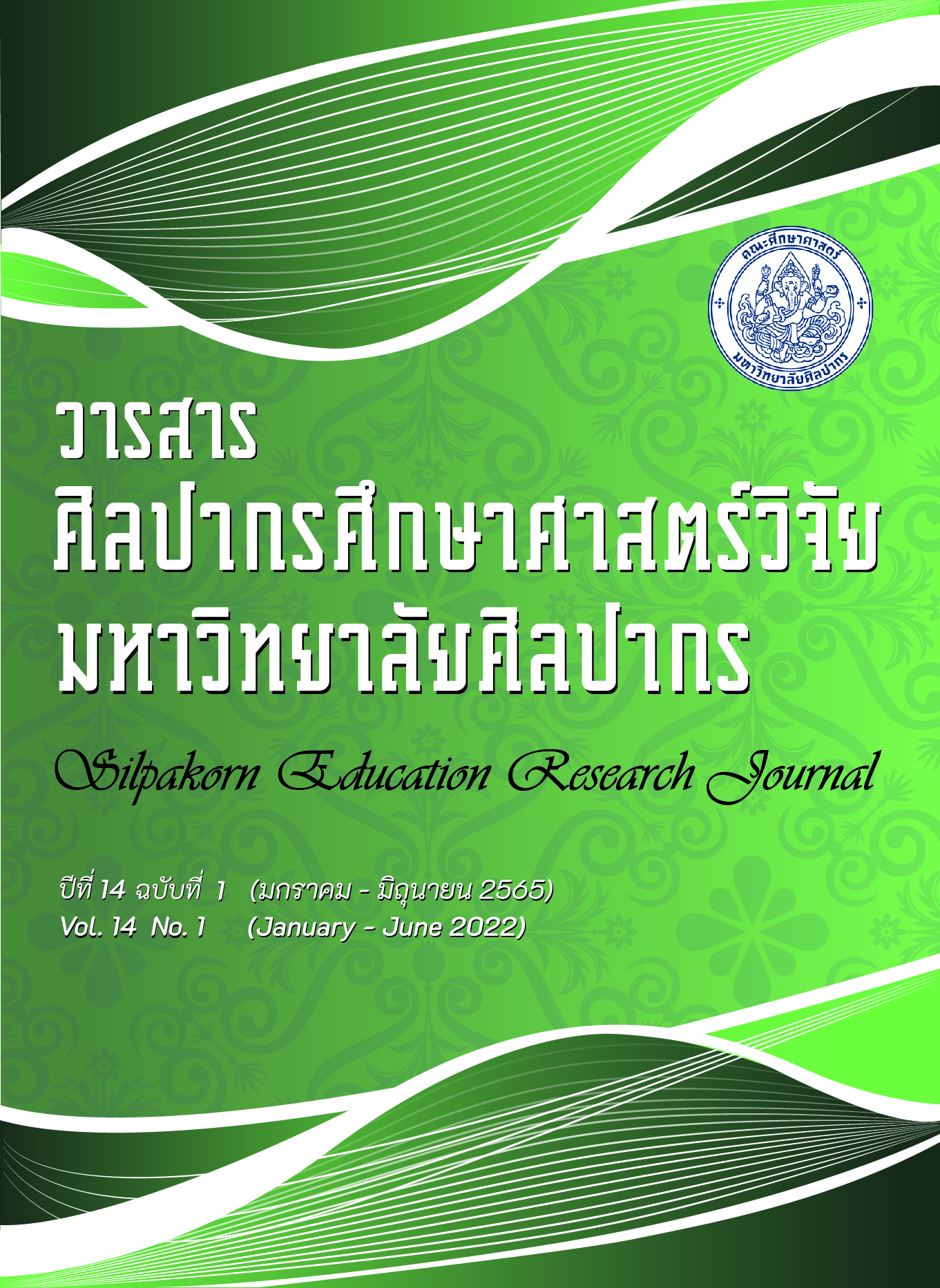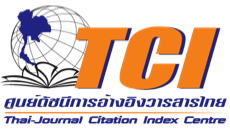การพัฒนารูปแบบการเรียนการสอนตามแนวคิดการเรียนรู้แบบผสมผสานที่ส่งเสริม ความสามารถการออกแบบกิจกรรมการเรียนรู้ สำหรับนิสิตครู
คำสำคัญ:
รูปแบบการเรียนการสอน, การเรียนรู้แบบผสมผสาน, กิจกรรมการเรียนรู้บทคัดย่อ
การวิจัยนี้มีวัตถุประสงค์เพื่อ 1) พัฒนารูปแบบการเรียนการสอนตามแนวคิดการเรียนรู้แบบผสมผสานที่ส่งเสริมความสามารถการออกแบบกิจกรรมการเรียนรู้ สำหรับนิสิตครู 2) เปรียบเทียบความรู้ก่อนและหลังการจัดการเรียนรู้ตามรูปแบบการเรียนการสอนที่พัฒนาขึ้น 3ศึกษาความสามารถการออกแบบกิจกรรมการเรียนรู้ หลังเรียนด้วยรูปแบบการเรียนการสอนที่พัฒนาขึ้น และ 4) เพื่อศึกษาดัชนีประสิทธิผลทางการเรียนก่อนและหลังเรียนด้วยรูปแบบการเรียนการสอนที่พัฒนาขึ้นตามเกณฑ์ 0.50 และประสิทธิภาพของรูปแบบการเรียนการสอนที่พัฒนาขึ้นตามเกณฑ์มาตรฐานของ เมกุยแกนส์ กลุ่มตัวอย่างที่ใช้ในการวิจัย คือ นักศึกษาระดับปริญญาตรี สาขาวิชาคณิตศาสตร์ศึกษา คณะศึกษาศาสตร์และพัฒนศาสตร์ มหาวิทยาลัยเกษตรศาสตร์ ปีการศึกษา 2564 จำนวน 35 คน เครื่องมือวิจัย ได้แก่ แบบทดสอบ และแบบประเมิน วิเคราะห์ข้อมูลโดยการวิเคราะห์ค่าเฉลี่ย ส่วนเบี่ยงเบนมาตรฐาน และ การทดสอบค่าทีแบบไม่อิสระกัน ผลการวิจัยพบว่า 1) รูปแบบการเรียนการสอน ประกอบด้วย หลักการของรูปแบบ วัตถุประสงค์ของรูปแบบ กระบวนการเรียนการสอนแบบเผชิญหน้าและการเรียนออนไลน์ด้วยกระบวนการเรียนรู้ 4 ขั้นตอน และการวัดและประเมินผล 2) ความรู้หลังจากเรียนด้วยรูปแบบการเรียนการสอนที่พัฒนาขึ้นสูงกว่าก่อนเรียนอย่างมีนัยสำคัญทางสถิติที่ระดับ.01 3) ความสามารถการออกแบบกิจกรรมการเรียนรู้ หลังเรียนด้วยรูปแบบการเรียนการสอนที่พัฒนาขึ้นอยู่ในระดับมากที่สุด 4) ดัชนีประสิทธิผลทางการเรียนของนิสิตครูก่อนและหลังเรียนด้วยรูปแบบการเรียนการสอนที่พัฒนาขึ้นมีค่า 0.67 ตรงตามเกณฑ์ดัชนีประสิทธิผล 0.50 และประสิทธิภาพของรูปแบบการเรียนการสอนที่ พัฒนาขึ้นมีค่าเท่ากับ 1.08 ตรงตามเกณฑ์มาตรฐานของเมกุยแกนส์
เอกสารอ้างอิง
Bloom B S. (1956). Taxonomy of Educational Objectives, the classification of educational goals – Handbook I: Cognitive Domain. New York: McKay.
Boonsiripunth, M. (2020). Get to know "New Normal" edition of the Royal Thai Council. [Online]. Retrieved December 1, 2020, from https://news.thaipbs.or.th/content/292126?fbclid=IwA R1L7vubqp2_ 1S2Yw66XhEZ9gBSOz4i999C6rn7Dz8cdmNiX0n53fazaWSU.
Campbell, D. T. and Stanley, J. C. (1963). Experimental and Quasi-Experimental Designs for Research. Boston: Houghton Mifflin Company.
Davidson M, Lickona T, Khmelkov V. (2007). “Smart and good schools: A paradigm shift for character education”. Education Week.;27(12): 40-2.
Ditsakun, S. (2000). "Collaborative Learning", Journal of Kasetsart Educational Review. 15(2): 1-8.
Huang, Ronghuai and Yueyang Zhou. (2003). Designing Blended Learning Focused on Knowledge Category and Learning Activities. Acessed February 1. Available from https://citeseerx.ist.psu.edu/viewdoc/download?doi=10.1.1.92.1948&rep=rep1&type=pdf.
Johnson, D. W. and Johnson, R. T. 1990. Learning Together and Alone. New Jersey:
Prentice - Hall.
Joyce, B. and Weil, M. (2009). Model of Teaching. London: Allyn and Bacon.
Kerres, M. and De Witt, C. (2003). “A didactical framework for the design of blended learning arrangements.” Journal of Education Media. 28(2-3): 101-113.
Khammani, T. (2010). Science of Teaching Pedagogy: Knowledge for organizing effective learning processes. Bangkok: Chulalongkorn University Printing House.
Ministry of Education. (2019). Announcement of the Ministry of Education regarding bachelor's degree qualifications Department of Education (4-year course) B.E. 2563, [Online]. Retrieved February 2, 2022, from http://www.ratchakitcha.soc.go.th/DATA/PDF/2562/E/ 056/ T_0012.PDF.
Osguthorpe, R. and Graham, C. (2003). “Blended learning environments: definitions and directions.” The Quarterly Review of Distance Education. 4(3): 227-233.
Poopamonkaipob, K. (2020). "MIAP Instruction for Learning Management on Vocational Education", Journal for Research and Innovation Institute of Vocational Education Bangkok 2(2): 14-19 (in Thai).
Saenboonsong, S. and Sintanakul, K. (2017). “The Dvevlopment of Blended Learning Model on Competency-based by Using MIAP Method of Undergraduate Students”. Technical Education Journal King Mongkut's University of Technology North Bangkok 8(2) :37-46.
Thongmaen, R. and et al. (2017). “Designing Classroom Learning Activity by Implementing a Formative Assessment Process for Primary School Students”. Research Methodology & Cognitive Science 15(2): 133-146.
Thorne, K. (2003). Blended learning: how to integrate online and traditional learning. London: Kogan Page. Accessed February 1. Available fromhttp://kenanaonline.com/files/0011/114 29/Blended-Learning.pdf.
Tongdeelert, P. (2004). A Proposed Collaborative Learning Model On Computer Network-Based Learning For Undergraduate Students With Different Learning Styles. Ph.D. Education (Educational Communications and Technology). Chulalongkorn University. Bangkok (Thailand).
Watanasuntorn, K. (2014). Classroom Research: Principles and Examples. [Online]. RetrievedJanuary 4, 2021, from http://rlc.nrct.go.th/ewt_dl.php?nid=1302.





